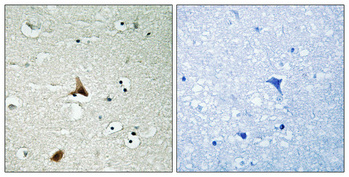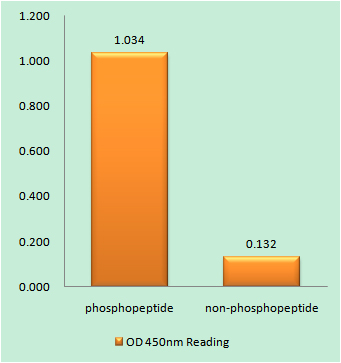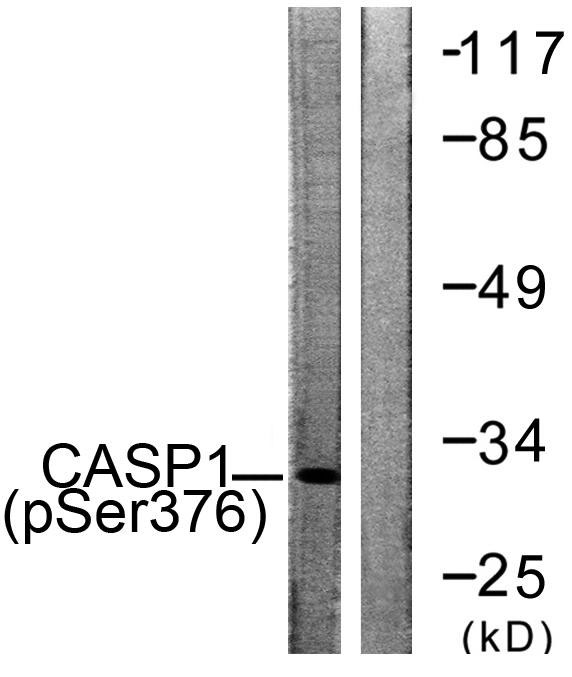Caspase-1 (phospho Ser376) Polyclonal Antibody
- Catalog No.:YP0749
- Applications:WB;IHC;IF;ELISA
- Reactivity:Human;Mouse;Rat
- Target:
- Caspase-1
- Fields:
- >>Necroptosis;>>Neutrophil extracellular trap formation;>>NOD-like receptor signaling pathway;>>Cytosolic DNA-sensing pathway;>>C-type lectin receptor signaling pathway;>>Amyotrophic lateral sclerosis;>>Pathogenic Escherichia coli infection;>>Shigellosis;>>Salmonella infection;>>Pertussis;>>Legionellosis;>>Yersinia infection;>>Influenza A;>>Coronavirus disease - COVID-19;>>Lipid and atherosclerosis
- Gene Name:
- CASP1
- Protein Name:
- Caspase1
- Human Gene Id:
- 834
- Human Swiss Prot No:
- P29466
- Mouse Gene Id:
- 12362
- Mouse Swiss Prot No:
- P29452
- Rat Swiss Prot No:
- P43527
- Immunogen:
- The antiserum was produced against synthesized peptide derived from human Caspase 1 around the phosphorylation site of Ser376. AA range:342-391
- Specificity:
- Phospho-Caspase-1 (S376) Polyclonal Antibody detects endogenous levels of Caspase-1 protein only when phosphorylated at S376.
- Formulation:
- Liquid in PBS containing 50% glycerol, 0.5% BSA and 0.02% sodium azide.
- Source:
- Polyclonal, Rabbit,IgG
- Dilution:
- WB 1:500 - 1:2000. IHC 1:100 - 1:300. ELISA: 1:20000.. IF 1:50-200
- Purification:
- The antibody was affinity-purified from rabbit antiserum by affinity-chromatography using epitope-specific immunogen.
- Concentration:
- 1 mg/ml
- Storage Stability:
- -15°C to -25°C/1 year(Do not lower than -25°C)
- Other Name:
- CASP1;IL1BC;IL1BCE;Caspase-1;CASP-1;Interleukin-1 beta convertase;IL-1BC;Interleukin-1 beta-converting enzyme;ICE;IL-1 beta-converting enzyme;p45
- Observed Band(KD):
- 45kD
- Background:
- This gene encodes a protein which is a member of the cysteine-aspartic acid protease (caspase) family. Sequential activation of caspases plays a central role in the execution-phase of cell apoptosis. Caspases exist as inactive proenzymes which undergo proteolytic processing at conserved aspartic residues to produce 2 subunits, large and small, that dimerize to form the active enzyme. This gene was identified by its ability to proteolytically cleave and activate the inactive precursor of interleukin-1, a cytokine involved in the processes such as inflammation, septic shock, and wound healing. This gene has been shown to induce cell apoptosis and may function in various developmental stages. Studies of a similar gene in mouse suggest a role in the pathogenesis of Huntington disease. Alternative splicing results in transcript variants encoding distinct isoforms. [provided by RefSeq, Mar 2012],
- Function:
- alternative products:Additional isoforms seem to exist,catalytic activity:Strict requirement for an Asp residue at position P1 and has a preferred cleavage sequence of Tyr-Val-Ala-Asp-|-.,enzyme regulation:Specifically inhibited by the cowpox virus Crma protein.,function:Thiol protease that cleaves IL-1 beta between an Asp and an Ala, releasing the mature cytokine which is involved in a variety of inflammatory processes. Important for defense against pathogens. Cleaves and activates sterol regulatory element binding proteins (SREBPs). Can also promote apoptosis.,PTM:The two subunits are derived from the precursor sequence by an autocatalytic mechanism.,similarity:Belongs to the peptidase C14A family.,similarity:Contains 1 CARD domain.,subunit:Heterotetramer that consists of two anti-parallel arranged heterodimers, each one formed by a 20 kDa (p20) and a 10 kDa (p10) subunit. The p20 subu
- Subcellular Location:
- Cytoplasm . Cell membrane .
- Expression:
- Expressed in larger amounts in spleen and lung. Detected in liver, heart, small intestine, colon, thymus, prostate, skeletal muscle, peripheral blood leukocytes, kidney and testis. No expression in the brain.
A high salt diet impairs the bladder epithelial barrier and activates the NLRP3 and NF‑κB signaling pathways to induce an overactive bladder in vivo Experimental and Therapeutic Medicine Jingwen Xue IHC Mouse 1:200 bladder tissue
- June 19-2018
- WESTERN IMMUNOBLOTTING PROTOCOL
- June 19-2018
- IMMUNOHISTOCHEMISTRY-PARAFFIN PROTOCOL
- June 19-2018
- IMMUNOFLUORESCENCE PROTOCOL
- September 08-2020
- FLOW-CYTOMEYRT-PROTOCOL
- May 20-2022
- Cell-Based ELISA│解您多样本WB检测之困扰
- July 13-2018
- CELL-BASED-ELISA-PROTOCOL-FOR-ACETYL-PROTEIN
- July 13-2018
- CELL-BASED-ELISA-PROTOCOL-FOR-PHOSPHO-PROTEIN
- July 13-2018
- Antibody-FAQs
- Products Images

- Immunohistochemical analysis of paraffin-embedded Human brain. Antibody was diluted at 1:100(4° overnight). High-pressure and temperature Tris-EDTA,pH8.0 was used for antigen retrieval. Negetive contrl (right) obtaned from antibody was pre-absorbed by immunogen peptide.

- Enzyme-Linked Immunosorbent Assay (Phospho-ELISA) for Immunogen Phosphopeptide (Phospho-left) and Non-Phosphopeptide (Phospho-right), using Caspase 1 (Phospho-Ser376) Antibody

- Immunohistochemistry analysis of paraffin-embedded human brain, using Caspase 1 (Phospho-Ser376) Antibody. The picture on the right is blocked with the phospho peptide.

- Western blot analysis of lysates from 293 cells, using Caspase 1 (Phospho-Ser376) Antibody. The lane on the right is blocked with the phospho peptide.



